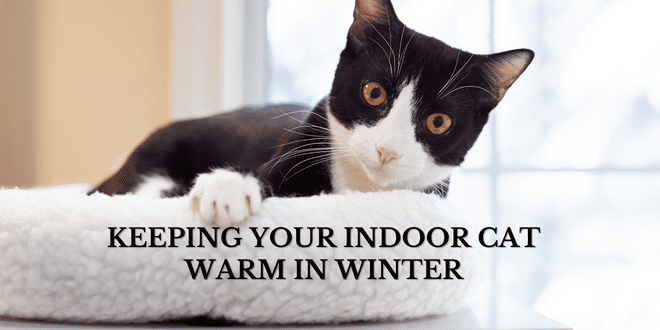
Cats often delight in finding a cozy, warm spot for their naps. It’s a familiar sight to discover your cat curled up in the sunniest corner of a room. As the colder months draw near, indoor cats, particularly older ones or those with arthritis, tend to gravitate toward the warmest spots in the house. Generally, cats have a preference for room temperatures slightly warmer than what humans typically prefer.
There are things you can do to help create safe, warm napping areas for your cat. This can be especially helpful for your older cat who may have stiff joints. The comfort of napping on a soft warm bed will ease some of that arthritic pain and stiffness. Heated bedding needs to be safe, so ensure your cat is able to freely move away from the heat should she get too warm. Cats have very thin skin that can burn easily.

Photo: Pam Johnson-Bennett
Heated Cat Beds
There are various types of heated beds to cater to different feline preferences. Some are semi-enclosed, while others resemble a donut shape or classic a heating pad. To select the ideal style, consider your cat’s typical bedding preferences for sleeping. If your cat enjoys burrowing completely under bed covers or prefers partial seclusion while sleeping, a cave-style bed might suit her well. Many cats find security in having their backs against something so if your cat prefers that but doesn’t like to be in a cave-like bed, the donut-shaped option might work. If your cat typically sprawls out when sleeping, a traditional flat heated bed might be your best option. Pay attention to your cat’s preferences and her usual position to help guide your decision.
Prioritizing safety is most important. The bed temperature should heat up to only the cat’s body temperature. The safest type of bed is a non-electric, self-heating one that reflects the cat’s own body heat. Position beds in elevated locations or in places where sunlight can add extra warmth. If you put the bed on an elevated spot, your cat must be able to easily access it. Older cats might benefit from ramps or cat stairs so they can safely reach their favorite elevated sleeping spots. For cats uncomfortable with climbing to higher spots, provide warm beds on ground level.
Some cat parents have wrapped heating pads in towels for the cats. If not monitored, even being on the lowest setting, there’s a chance your cat could get burned. It’s better to invest in a heated bed made especially for pets or one of the non-electric, self-heating ones.
Other Ways to Create Warmth for Your Cat
Your cat probably enjoys sitting at the window to watch the outdoor activity. If there’s a draft there, it’ll be uncomfortable so take care of any leaks, especially at favored window locations. Place a padded window perch at the window so your cat doesn’t have to sit on the cold, hard window sill. There are also heated window perches available.
Leave a couple of blankets around for your cat for snuggling. Try crumpling the blanket up a bit so your cat can easily burrow underneath to stay warm.
If you typically lower your thermostat for the times during the day while you’re at work or before you go to bed, remember to take your cat’s comfort into consideration. A healthy cat with a good coat will be fine but an older, thinner, or ill cat may be uncomfortable. Provide warm places within the house or raise your thermostat just enough to take the chill off. Cats like warmer room temperatures so keep that in mind before you lower your thermostat too much.
Let Your Cat Take Advantage of the Sun in the Indoor Environment
The image of an indoor cat stretched out and enjoying an afternoon snooze in the path of where the sun comes streaming in the window is a classic. For most cats, feeling the warmth of the sun streaming through the window feels wonderful. Open curtains during the day to let the sun come in.

Photo: Pam Johnson-Bennett
Keep Moisture in the Air For Your Cat’s Comfort
The air inside the house in the winter can get very dry. A humidifier in the house may help your cat feel a bit more comfortable and will cut down on static electricity.
Monitor Your Cat’s Calorie Intake
As your cat gets older she may have a change in appetite and could start losing weight. Proper calorie intake helps keep the body warm. It’s important your cat is getting enough calories daily so if there has been a change in appetite, have her checked by the veterinarian. An increase in food or a change in the nutritional program may be needed. Monitor your cat’s food intake and also keep tabs on weight, especially as she gets older. While some cats gain weight with age, others may lose enough that they have trouble keeping comfortably warm.
Maintain Your Cat’s Activity Levels
Keep up a schedule of daily interactive playtime to keep your cat active. Customize the play session to fit your cat’s state of health and ability. Your cat needs to have some fun every day. Playtime is beneficial physically and emotionally. Get kitty’s juices flowing so dust off those interactive toys and do a play session today! Being active is important for staying warm. Even an older cat will appreciate some type of playtime. It doesn’t mean your cat has to do leaps and jumps — just some form of movement may help.
The Garage and Basement aren’t Cat-Friendly
Some cat parents set up the cats’ litter boxes in the garage or basement. For an older cat or one who doesn’t handle the cold as well, this can be very uncomfortable when it comes time to take care of personal business. A litter box set up in the warmth of the house is a much better option.
It’s also not a good idea to confine the cat to the garage or basement at night. A cold, damp environment certainly isn’t a comfortable place to sleep.
Think about your own comfort level. If you’re cold or uncomfortable, chances are your cat is as well.
Need More Information?
For more information on cat behavior, care and training, refer to the books by best-selling author Pam Johnson-Bennett. Pam’s books are available at bookstores and online. We’ve included Amazon links on our website for your convenience.
If you have a question regarding your cat’s health, please contact your veterinarian. This article is not intended as a replacement for your cat’s veterinary care.
 Problem Solving & Advice by Pam Johnson-Bennett Cat Behavior Expert & Best-selling Author
Problem Solving & Advice by Pam Johnson-Bennett Cat Behavior Expert & Best-selling Author




